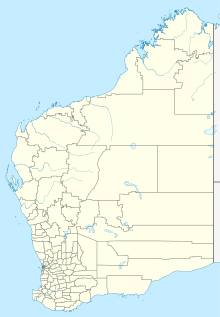Wittenoom Gorge Airport
Wittenoom Gorge Airport | |||||||||||
|---|---|---|---|---|---|---|---|---|---|---|---|
| Summary | |||||||||||
| Airport type | Defunct | ||||||||||
| Serves | Wittenoom, Western Australia | ||||||||||
| Location | Wittenoom Contaminated Site | ||||||||||
| Closed | 1966 | ||||||||||
| Coordinates | 22°13′35″S 118°21′41″E / 22.22639°S 118.36139°E | ||||||||||
| Map | |||||||||||
| Runways | |||||||||||
| |||||||||||
Wittenoom Gorge Airport (ICAO YWIT, IATA WIT) is a former airfield that played a role in Wittenoom's asbestos industry. The airfield was operated by the Department of Civil Aviation. It is located in Wittenoom, Pilbara Region, Western Australia.[1]
History
[edit]In March 1945, the airfield was rated “A” class in favour of winds and dry weather.
In 1946, Airlines (WA) and competitor MMA opened up a new route that included Wittenoom along with other cities to carry workers and supplies to the asbestos mining site.
In 1955, runway 15/33 (5540 ft long) dirt strip was closed while two other runways were being used.[2]
Due to concerns of variations of the routes and subsidies, in 1955, Airlines (WA) and MMA merged forming MacRobertson Miller Airlines LTD.[3][4]

Cemetery
[edit]Located in the proximity of Wittenoom Gorge Airport, a small cemetery can be found with approximately 8 graves onsite.[5][6]
References
[edit]- ^ "Wittenoom Airport (abandoned), Ashburton".
- ^ National Archives of Australia (1944–1955). "Wittenoom Gorge - Via Roebourne WA - aerodrome". Retrieved 2024-08-20.
- ^ Geoff Goodall. "Part 2. MMA West Australian Operations". Retrieved 2024-08-20.
- ^ Airlines (W.A.) Ltd, [Amalgamation of Airlines (WA) Ltd. and MacRobertson-Miller Aviation Co. Ltd.], retrieved 3 October 2024
- ^ "Lonely Graves - Wittenoom Cemetery". Retrieved 2024-08-20.
- ^ "Wittenoom Gorge News". Northern Times. Vol. 75, no. 28. Western Australia. 12 July 1951. p. 8. Retrieved 3 October 2024 – via National Library of Australia.

